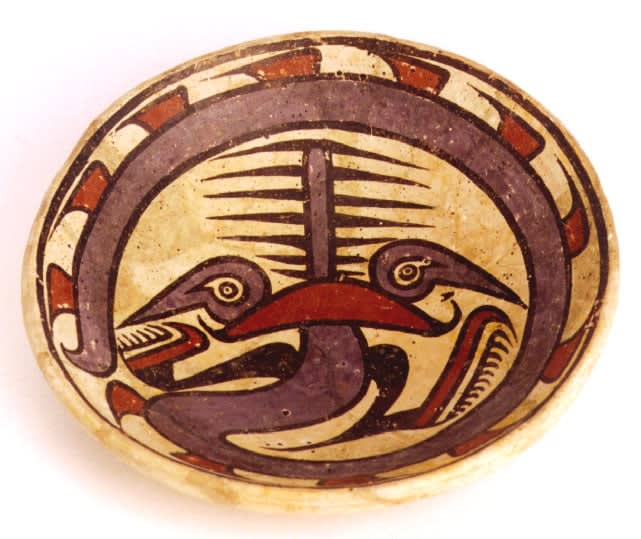Cocle Terracotta Polychrome Bowl, 500 CE - 1000 CE
Terracotta
7.5
PF.4028
Archaeological excavations in the Cocle Province located in Central Panama have revealed that an ancient civilization once inhabited these lands. The findings suggested that the so-called Cocle culture arose around...
Archaeological excavations in the Cocle Province located in Central Panama have revealed that an ancient civilization once inhabited these lands. The findings suggested that the so-called Cocle culture arose around 500 A.D. and lasted until about 1000 A.D. Although their dating is roughly contemporaneous with the Diquis culture to the north in modern day Costa Rica, the art they left behind suggests that they were a unique, independent civilization. Cocle art, which consists primarily of unslipped or buff slipped pottery and terracotta sculptures, is distinguished by their polychrome hues and lively asymmetrical motifs which often include animal themes.
The ceramic vessels of Ancient Panama comprise some of the most intriguing and unique iconographic art in the world. The artists in the different regions created a style of painting which has no parallel. Over the centuries countless, and anonymous, artisans continued to elaborate and develop themes inherited from their predecessors. To explore the variety of these themes is to embark on a journey of discovery and revelation. Innovation, in the sense of creating completely new images, was not an objective for the Panamanian artist. He or she worked within a certain context, giving expression to established imagery, while adding their own intensity of purpose to each object. To understand Panamanian art, it is necessary to delve into its inner nature. This lovely bowl is characteristic of the Macaracas period that began roughly 800 A.D. The design is of an abstract sawfish beautifully interweaving around the sides of the vessel. The gorgeous blue/lavender color of the body stands out starkly against the cream background; highlighted by black borders and touches of red in the scales along the tail, connecting the eyes and at the ends of the fins. It is in fact this red, which gives dynamic movement, as symbols of energy, animating the vessel with life. Polychromatic zigzag shapes were associated with lightening and fertility; with the visual effect of forcing ones eyes to swirl around the edge of the bowl, and then come to rest within the powerful gaze of the sawfish. Whether it stands on its pedestal base or hangs on a wall this wonderful bowl will always mesmerize. After millennia its ability to enchant remains undiminished.
The ceramic vessels of Ancient Panama comprise some of the most intriguing and unique iconographic art in the world. The artists in the different regions created a style of painting which has no parallel. Over the centuries countless, and anonymous, artisans continued to elaborate and develop themes inherited from their predecessors. To explore the variety of these themes is to embark on a journey of discovery and revelation. Innovation, in the sense of creating completely new images, was not an objective for the Panamanian artist. He or she worked within a certain context, giving expression to established imagery, while adding their own intensity of purpose to each object. To understand Panamanian art, it is necessary to delve into its inner nature. This lovely bowl is characteristic of the Macaracas period that began roughly 800 A.D. The design is of an abstract sawfish beautifully interweaving around the sides of the vessel. The gorgeous blue/lavender color of the body stands out starkly against the cream background; highlighted by black borders and touches of red in the scales along the tail, connecting the eyes and at the ends of the fins. It is in fact this red, which gives dynamic movement, as symbols of energy, animating the vessel with life. Polychromatic zigzag shapes were associated with lightening and fertility; with the visual effect of forcing ones eyes to swirl around the edge of the bowl, and then come to rest within the powerful gaze of the sawfish. Whether it stands on its pedestal base or hangs on a wall this wonderful bowl will always mesmerize. After millennia its ability to enchant remains undiminished.
